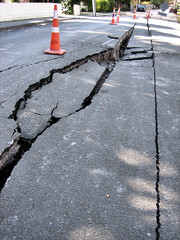
Search
Images for Earthquake damage; more images...
People in Disasters Conference - A Community Wellbeing Centric Approach to…
Videos, UC QuakeStudies
A video of a presentation by Dr Scott Miles during the Community Resilience Stream of the 2016 People in Disasters Conference. The presentation is titled, "A Community Wellbeing Centric Approach to Disaster Resilience".The abstract for this presentation reads as follows: A higher bar for advancing community disaster resilience can be set by conducting research and developing capacity-building initiatives that are based on understanding and monitoring community wellbeing. This presentation jumps off from this view, arguing that wellbeing is the most important concept for improving the disaster resilience of communities. The presentation uses examples from the 2010 and 2011 Canterbury earthquakes to illustrate the need and effectiveness of a wellbeing-centric approach. While wellbeing has been integrated in the Canterbury recovery process, community wellbeing and resilience need to guide research and planning. The presentation unpacks wellbeing in order to synthesize it with other concepts that are relevant to community disaster resilience. Conceptualizing wellbeing as either the opportunity for or achievement of affiliation, autonomy, health, material needs, satisfaction, and security is common and relatively accepted across non-disaster fields. These six variables can be systematically linked to fundamental elements of resilience. The wellbeing variables are subject to potential loss, recovery, and adaptation based on the empirically established ties to community identity, such as sense of place. Variables of community identity are what translate the disruption, damage, restoration, reconstruction, and reconfiguration of a community's different critical services and capital resources to different states of wellbeing across a community that has been impacted by a hazard event. With reference to empirical research and the Canterbury case study, the presentation integrates these insights into a robust framework to facilitate meeting the challenge of raising the standard of community disaster resilience research and capacity building through development of wellbeing-centric approaches.
Mapping shallow groundwater salinity in a coastal urban setting to assess …
Research Papers, Lincoln University
Study region: Christchurch, New Zealand. Study focus: Low-lying coastal cities worldwide are vulnerable to shallow groundwater salinization caused by saltwater intrusion and anthropogenic activities. Shallow groundwater salinization can have cascading negative impacts on municipal assets, but this is rarely considered compared to impacts of salinization on water supply. Here, shallow groundwater salinity was sampled at high spatial resolution (1.3 piezometer/km²), then mapped and spatially interpolated. This was possible due to a uniquely extensive set of shallow piezometers installed in response to the 2010–11 Canterbury Earthquake Sequence to assess liquefaction risk. The municipal assets located within the brackish groundwater areas were highlighted. New hydrological insights for the region: Brackish groundwater areas were centred on a spit of coastal sand dunes and inside the meander of a tidal river with poorly drained soils. The municipal assets located within these areas include: (i) wastewater and stormwater pipes constructed from steel-reinforced concrete, which, if damaged, are vulnerable to premature failure when exposed to chloride underwater, and (ii) 41 parks and reserves totalling 236 ha, within which salt-intolerant groundwater-dependent species are at risk. This research highlights the importance of determining areas of saline shallow groundwater in low-lying coastal urban settings and the co-located municipal assets to allow the prioritisation of sites for future monitoring and management.
Disasters and investment: Assessing the performance of the underlying econ…
Research Papers, Lincoln University
Disasters are often followed by a large-scale stimulus supporting the economy through the built environment, which can last years. During this time, official economic indicators tend to suggest the economy is doing well, but as activity winds down, the sentiment can quickly change. In response to the damaging 2011 earthquakes in Canterbury, New Zealand, the regional economy outpaced national economic growth rates for several years during the rebuild. The repair work on the built environment created years of elevated building activity. However, after the peak of the rebuilding activity, as economic and employment growth retracts below national growth, we are left with the question of how the underlying economy performs during large scale stimulus activity in the built environment. This paper assesses the performance of the underlying economy by quantifying the usual, demand-driven level of building activity at this time. Applying an Input–Output approach and excluding the economic benefit gained from the investment stimulus reveals the performance of the underlying economy. The results reveal a strong growing underlying economy, and while convergence was expected as the stimulus slowed down, the results found that growth had already crossed over for some time. The results reveal that the investment stimulus provides an initial 1.5% to 2% growth buffer from the underlying economy before the growth rates cross over. This supports short-term economic recovery and enables the underlying economy to transition away from a significant rebuild stimulus. Once the growth crosses over, five years after the disaster, economic growth in the underlying economy remains buoyant even if official regional economic data suggest otherwise.



